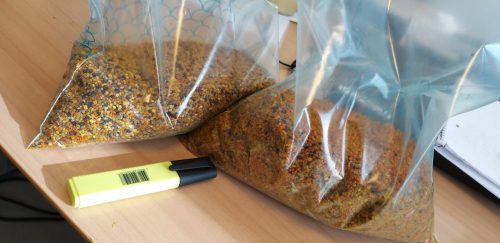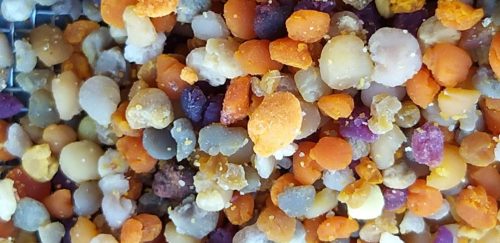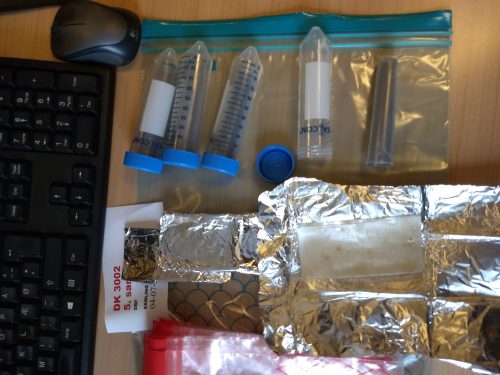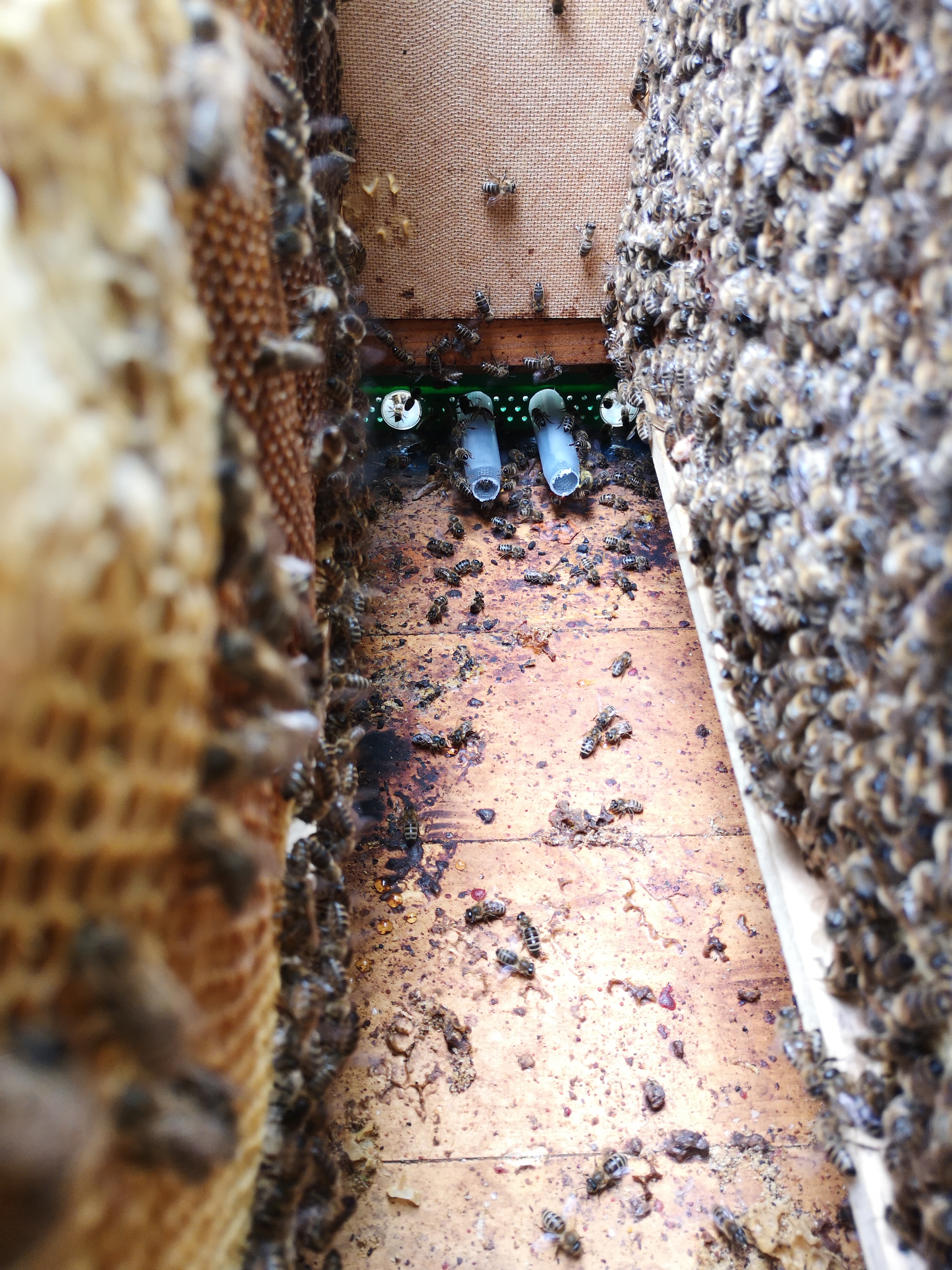Pollen, beebread, and beehold tube samples from Denmark arrived at the lab of CIMO/IPB on Wednesday, after a two day-day trip. Samples arrived in good conditions. Now they are stored at -20 C awaiting for DNA extraction.
Alice Pinto
Shit happens!
Yes, that happens. 6th sampling period starts today. In Denmark, we try to do the sampling on Fridays. So, this morning in one of the test apiaries we went out to mount the pollen trap. Shit happens. We did forget to unmount the traps. So, two traps where active for more then 10 days. One colony gave 1176 gram of pollen and the neighbor one gave 753 grams of pollen. This showing us that the last sampling period has been very active and productive for the colony. Our experience is that we of cause need flight condition with nice weather. But if we compare. Then colonies that are not in balance, we see little or no pollen collection. Could be a queen less colony. We have areas now where the lack of flowering plants now is so low, that this is a hindrance for further pollen collection.
Notice the difference in the colors of the two colonies.
Never mind, mistake done, let us enjoy the beauty and variety of pollen in bees’ colonies.
Flemming




The first eight months of the Insignia pilot study
A mail, drawing my attention to an EU bio-monitoring call caught my attention. Wow! This is an ultimate chance to demonstrate the honeybee colony’s bio-sample feature as a tool for environmental monitoring. More colleagues had this idea and we found each other in this shared interest. Obviously, this resulted in the start of a consortium which expanded like a swan glue game, resulting in the final Insignia consortium with experts of all required scientific disciplines. Many telemeetings later, with launching, discussing and evaluating ideas, we had a clear interpretation of the call and routes to achieve this. Our focus should be on developing and testing a scientifically substantiated citizen science protocol and the application of passive samplers to meet both the non-invasive and innovative requirements in the call and applying the common matrices trapped pollen and beebread as benchmarks.
Writing the final submission, waiting for the selection and the selection itself sounds simple but was stressful, hectic and required skills for all of us as there were science, statistics, grammar, flow charts, budgeting, summarizing, planning, financial recordings, (very) frequent communicating and reporting, use of social media, etc. etc..
Now we are eight months ahead and we already do have an impressive palmarès thanks to all particip[ants involvement and energy. Passive samplers were developed, testing schemes were made, discussed and implemented, picture/ instruction manual written, test apiaries selected, five samplings done, first analyses done, progress in molecular detection of pollen made, social study conducted, a lime survey running, the first data for evaluation of the Corine database collected, an active social media life and several practical issues addressed, solved or parked.
Still, five samplings to go in year 1 and the plenary discussions in January 2020 on best practices both scientifically, practically and citizen-scientifically. It feels good to cooperate in the consortium and, I am looking forward to the coming exciting 20 months.
The enigma of sample coding
Communication in itself is simply a matter of sending and receiving a message. This implies on one hand, a clear message. On the other hand, every receiver interprets the message within his/her own reference frame. This makes communication a difficult issue anyway. In Insignia, this shows in interpreting the coding of the Insignia samples. This coding is clearly explained and communicated in the picture manual. On the other hand, other lay-outs are suggested in the conviction that his/ her interpretation is better. Remember that there is a chain of “receivers” and the coding is six-dimensional: country, apiary, colony, date, material and replicates in time. Miscoding will for sure results in potential misinterpretations and certainly in time and energy loss in sorting out the samples. The solution is simple. Stick to the appointments and don’t make labeling

an enigma.
The 5th sampling in Denmark by Flemming and Ole and assistance of Valters and Sjef
The best way to learn all the ins and outs of Insignia sampling is simply doing it. Flemming and Ole were so kind as to invite me and Valters to assist in the 5th sampling. Due to mine and Valters agenda, the 5th sampling in Denmark was brought forward to Thursday and Friday 4 and 5 July. It was an interesting learning experience for myself and Valters to prepare package and coding, to do the pollen collection, taking out and inserting respectively the old and new APIStrips and Beehold tubes, collecting beebread and emptying the pollen trap, to have an indication of the time and energy spent on the labour before and after the field work. I learned/ was confirmed that coding/ sample preparation requires a consequent and accurate effort, beebread picking takes time in two ways, looking for the best frame and the picking itself, the facility of the APIStrip and Beehold tube change and the every time wonderful view of the diversity of pollen in the trap. All samples are stored in the freezer.
Just a reminder for sending the samples latest half July as described in the picture manual except alcohol on trapped pollen for PCR (and not for pesticide analyses).
Pollen identification
– trapped pollen for pollen identification are sent to Alice in alcohol 96%,
– Beehold tubes and beebread straws are sent, wrapped together with frozen icepacks in an insulating package of e.g. plastic foil with air bubbles or styrofoam box.
Pesticide residues
– APIStrips, Beehold tubes, trapped pollen and bee bread are sent to the labs wrapped together with frozen icepacks from the freezer in an insulating package of e.g. plastic foil with air bubbles or styrofoam box.
– The division, where to send the samples for pesticide residue analyses will be announced in time.

Latvija ir Insignia projekta dalibniece

Insignia recently got presented in the Latvian Beekeepers Magazine “Biskopis”. The association has 3.200 beekeepers, but even additional copies were distributed with the country. In total there are 4.200 beekeepers having 102.000 colonies. Main flow is oilseed rape, lime tree, clover, heather etc.
Latvia is an important part of the citizen science in year 2. Latvia is our most north situated beekeeping. Very mixed landscape, with lot of forest areas and intense farming.
Valters Brusbardis
The danish pollentrap
The main aim of INSIGNIA is the citizen science protocol for honeybee colony as bio-sampler for pesticides. But to reach that goal, loot of activities is going on. How to sample the pollen? In Denmark we have been working with a pollen and propolis group for 2 years already, when we got involved in INSIGNIA. All other countries used the famous front yellow pollen trap. All agreed on this is not the best one, but it works. For us, it was natural to follow our own route. The development of a new pollen trap that we got inspiration on in Switzerland. We did adjust it; we feel we did improve it and we did fit it to the Danish types of hives. We made a version 1, did test it all the summer and found mistakes. It was very exciting to involve the beekeepers in our project, and we talked hours about suggested improvements. We did recruit all our citizens scientist within this pollen group. With the INSIGNIA project we made a version 2. The one presented on the video. A very nice side-effect of the INSIGNIA project. See the result in this video.
Samples in the laboratory!
The first samples from citizen scientists arrived in the labs of the national coordinators. Their next way is now to be send to the specialist labs for further analysis. It is of great importance that the samples arrive there in a well preserved and labelled manner!

Deformed wing virus

In the INSIGNIA project, we do look very closely into the colonies as a natural part of the project. At the last sampling we found Deformed Wing Virus (DWV) in one of the INSIGNIA colonies. DWV is associated to a heavy varroa load. In this case we saw several bees with DWV, indicating that the colony did overwinter with to high mite load. Asking the beekeeper, we recognized that he has been experimenting last year using fewer treatments. As new treatment he used oxalic acid evaporation in December. Normally we regard an oxalic acid tricking as very effective in the time of bloodless colonies. Either the evaporation was not effective or there was a relatively large amount of varroa in the colony end December. Normally we say that having DWV in the colony, it is too late to threat. Anyway, beekeeper decided to make a total brood removal in the colony, to see if it is possibly to make it healthy.
Flemming Vejsnæs
A look from inside
The inside view from colony 3 (see here for construction) explains why bees learn to get out through the exit tubes, but enter through the inside tubes!

